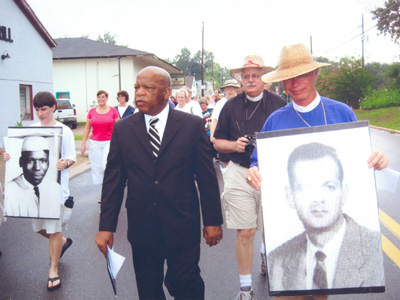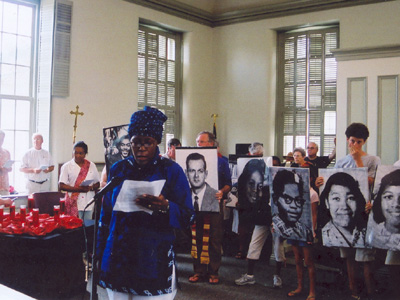 |
||||||||||
 |
||||||||||
|
1355: Celebration of Blessed Jonathan Daniels and the
Martyrs of Alabama, Lowndes County, Hayneville, Alabama, USA Mystery Worshipper: The Rev. Dr B. The church: Celebration of Blessed Jonathan Daniels and the Martyrs of Alabama, Lowndes County, Hayneville, Alabama, USA. Denomination: The celebration was according to the rite of the Episcopal Church in the USA. Comment: See the discussion thread on this report. The building: Most of the celebration took place at the Lowndes County Courthouse, a white stone building dating from the early 1900s, with clock tower and a Greek porch featuring Doric columns. The church: The story of this celebration comprises a grim chapter in the American civil rights struggle of the 1960s. Jonathan Daniels, a student at the Episcopal seminary in Cambridge, Massachusetts, traveled to Lowndes County, Alabama, in 1964 to participate in a voting rights demonstration. Daniels, who was white, and several black demonstrators were arrested and kept in the county jail for several days. Upon their release, they were accosted outside a local shop by one Thomas Coleman, an unemployed construction worker, who aimed his rifle at a teenage girl in the group. Daniels stepped in front of the girl as Coleman fired and was killed instantly. Coleman was arrested and tried but was found innocent of all charges. The attorney general of Alabama was outraged at the verdict, calling it an example of "the democratic process going down the drain of irrationality, bigotry and improper law enforcement." However, Charles Carpenter, the Episcopal bishop of Alabama at the time, refused to condemn Coleman's acquittal, issuing instead a bland statement deploring the bloodshed caused by "troublemakers" who had come to Alabama from other states. But the event helped shock the Episcopal Church into changing its views toward the civil rights struggle. In 1991 the Church declared Jonathan Daniels a martyr, designating August 14, the day of his arrest, as his feast day. Daniels is one of 15 persons honored in Canterbury Cathedral's Chapel of Martyrs. The celebration was organized as an annual event about a half dozen or so years ago by Bishop Marc Andrus, at the time suffragan bishop of Alabama. The neighborhood: In 1964 when Daniels was killed, Lowndes County and the surrounding counties were predominantly African American but there were no blacks in the county government. Daniels was there to assist African American voters who were being unconstitutionally prevented from registering to vote. African Americans still make up a majority of Lowndes County but they now also are well represented in the government. However, the poverty in this part of Alabama is still appalling. Lowndes County is a gritty collection of cattle farms and dying towns living in a hand-me-down past. The cast: Bishop Andrus, now Bishop of California, presided, assisted by the Rt Rev. Phillip Duncan, Bishop of the Central Gulf Coast. The preacher was the Hon. John Lewis, Member of Congress for the Fifth District of Georgia. The date & time: Saturday, August 12, 2006, 11.00am. What was the name of the service? Procession and Holy Eucharist. How full was the building? Very full. Most seats were occupied. The community that meets to celebrate the life and witness of Jonathan Daniels is diverse by most standards. It appeared that a slight majority were under 30 but there were many older (over 60) folks as well. There were probably 20 or 30 black worshippers in a congregation of about 200. Did anyone welcome you personally? Not exactly. This, however, was not a typical service. There were people with orders of service who helped organize the congregation in front of the courthouse. Was your pew comfortable? The courthouse benches were much like standard church pews and were adequate. How would you describe the pre-service atmosphere? Festively reverent! This service has taken place annually for several years now. People were greeting old friends and catching up on news. Many people milled about Congressman Lewis, talking to him and getting his autograph. What were the exact opening words of the service? "Blessed be God: Father, Son, and Holy Spirit." What books did the congregation use during the service? Only the service leaflet. It contained the entire text of the eucharistic liturgy, plus words for the hymns. What musical instruments were played? There were no instruments. The music was entirely a cappella and lovely. A young black man and an older black woman (sorry but I did not get their names) led the singing, which consisted entirely of freedom songs, e.g. "Keep your eyes on the prize" and "Ain't gonna let nobody turn me around." But I was surprised and disappointed that we did not sing "We shall overcome." Did anything distract you? Since a goodly part of the celebration took place out of doors, there were the usual distractions of cars driving through the square, curious onlookers stopping to watch (and sometimes join in) and so on. Fortunately, Hayneville is a very slow-paced town and there wasn't much going on that day. It did rain a bit, too, which was somewhat distracting. Was the worship stiff-upper-lip, happy clappy, or what? Everything about this celebration was fascinating. It was a good combination of order and freedom. The liturgy was a standard holy eucharist with some unique features. The liturgy of the word began in front of the courthouse. Next we moved in procession to the jail, where the New Testament lesson was read. Then we moved to the place of Daniels' death, where a first-hand account of his death was read from the book Outside Agitator by Charles Eagles and the gospel was proclaimed. After the readings, people were invited to venerate the place of Daniels' martyrdom. Finally we returned in procession to the courthouse, where the eucharist resumed in the courtroom where Coleman was acquitted. The judge's bench became the altar.  Exactly how long was the sermon? 20 minutes. On a scale of 1-10, how good was the preacher? 9 – Congressman Lewis would have made a terrific pastor had he not gone into politics. It was obvious from his delivery and some of the content that the preacher was also a politician, but he did not just give a standard stump speech – he preached the good news of God in Christ. Lewis told a bit of his story: His father was a sharecropper in south Alabama and Lewis was one of seven children. He was always interested in church and used to preach to the chickens on the farm! When he was in his early 20s, Lewis helped organize the voter registration campaigns in Lowndes County and the surrounding area, and he participated in the Rev. Martin Luther King's march for voting rights from nearby Selma to Montgomery. In a nutshell, what was the sermon about? His text was from Mark 8.34: "If any man would come after me, let him deny himself, and take up his cross, and follow me." We need to "get in the way" as Jesus and Jon Daniels did. Which part of the service was like being in heaven? Most of the service was heavenly. I grew up in Alabama during the civil rights era but was too young to understand fully what was going on, much less participate. This service helped me feel just a little of what it must have been like in those difficult and dangerous days 40 ago to march and sing for justice. But I was moved to tears when, during the offertory, the celebrants read the names of 12 men and women (black and white, young and old) who were killed in Alabama because of their participation in the civil rights movement. As each name was read, someone holding a photo of that person stood up, walked to the altar (i.e. the judge's bench), faced the congregation and said, "Present." Ultimately, a line of "martyrs" faced the congregation from the front of the assembly. This was an extremely vivid illustration of the truth that in the eucharist the church triumphant and the church militant come together. And which part was like being in... er... the other place? There was really nothing to criticize in the service itself. The only negative was the scorching heat, but that's inevitable in Alabama in August. What happened when you hung around after the service looking lost? Everyone was invited down to the courthouse basement where a "soul food" lunch had been set out. How would you describe the after-service coffee? The food looked adequate but I was much too hot and tired to eat. How would you feel about making this church your regular (where 10 = ecstatic, 0 = terminal)? 10 – Celebrating the eucharist in the courtroom where Daniels' killer was acquitted was profoundly moving. The judge's bench where the verdict of "not guilty" was pronounced became the altar where Christ in the eucharist takes upon himself the sins of the world. Christ's love for all of mankind engulfs and transforms the injustice of Daniels' murder and the murders of the other martyrs represented there. The eucharist proclaims a higher justice, where reconciliation replaces estrangement. Did the service make you feel glad to be a Christian? I felt both chastened and exultant. Chastened because as a white Alabamian I felt complicit in the injustices perpetrated against Daniels and the other martyrs. However, I also felt exultant because today black and white Christians can gather, break bread, sing freedom songs, and worship together in a place where a martyr shed his blood to change an evil system. What one thing will you remember about all this in seven days' time? It was an unforgettable service. I will long remember the music, the powerful sermon, and most of all the way a place of injustice became a place of justice and reconciliation. |
|
|
||||||||||||||||||||||||||||||||||||
| More Mystery Worshipper reports | |||||||||||||||||||||||||||||||||||||||
 |
|||||||||||||||||||||||||||||||||||||||






